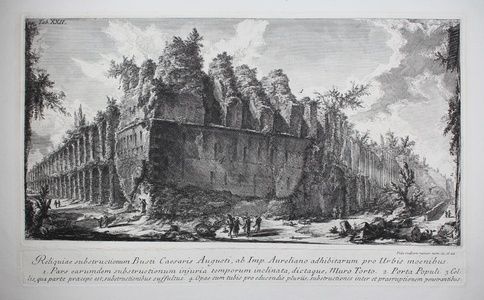| Method | Etching |
| Artist | Giovanni Battista Piranesi |
| Published | [Roma, 1762] |
| Dimensions | Image 210 x 420 mm, Plate 255 x 425 mm |
| Notes |
Plate XXII of Il Campo Marzio dell'Antica Roma, showing the area immediately southwest of the modern day Villa Borghese and the substructure of the so-called 'Pyre of Augustus', later incorporated into the Aurelian Walls during their construction in the later third century AD. The view also includes parts of the Republican era 'Murus Tortus,' and the Porta Populi in the distance. The Bustum of Augustus was the assumed location of the emperor's funeral pyre, set up in the gardens adjacent to his Mausoleum on the Campus Martius as part of the grand funerary procession that carried his coffin from Nola to Rome. Piranesi equated the substructure of the so-called 'Twisted Wall,' of Republican date, with the Bustum, though it is unclear if the structure that was built into the later Aurelian wall was the original platform upon which the pyre sat, or a later monumentalizing of the pyre's location. The regular openings in the structure, which Piranesi calls by the borrowed Greek title of 'opae,' were allegedly built for the drainage of rainwater from within. Piranesi's Il Campo Marzio dell'Antica Roma was an ambitious attempt to document and study the extant Roman remains on the Field of Mars. An excellent illustration of the artist's talents as an architect and antiquarian, the work included maps of the area, views of principle monuments and ruins, as well as detailed illustrations of archaeological objects and fragments. Published in 1762, the Campo Marzio was dedicated to Piranesi's fellow architect, Robert Adam. Giovanni Battista (also Giambattista) Piranesi (1720 – 1778) was an Italian artist famous for his etchings of Rome and of fictitious and atmospheric "prisons" (the Carceri d'Invenzione). He was a major Italian printmaker, architect and antiquarian. The son of a Venetian master builder, he studied architecture and stage design, through which he became familiar with Illusionism. During the 1740's, when Rome was emerging as the centre of Neoclassicism, Piranesi began his lifelong obsession with the city's architecture. He was taught to etch by Giuseppe Vasi and this became the medium for which he was best known. Wilton-Ely 584, F453, C438a. Condition: Inscription engraved and printed on a separate plate directly below the image plate. Crease to top left corner of sheet, not affecting image. Minor time toning to plate and platemark, otherwise a dark clean impression with full margins. Framed in an antique gilt frame. |
| Framing | framed |
| Price | £725.00 |
| Stock ID | 49600 |

